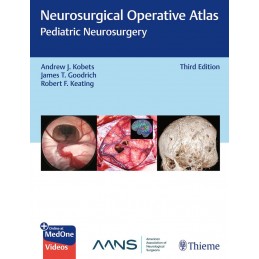- Reduced price
- New

Order to parcel locker

easy pay


 Delivery policy
Delivery policy
Choose Paczkomat Inpost, Orlen Paczka, DHL, DPD or Poczta Polska. Click for more details
 Security policy
Security policy
Pay with a quick bank transfer, payment card or cash on delivery. Click for more details
 Return policy
Return policy
If you are a consumer, you can return the goods within 14 days. Click for more details
Neurosurgical Operative Atlas:: Pediatric Neurosurgery, Third Edition edited by Andrew J. Kobets, the late James T. Goodrich, and Robert F. Keating showcases the latest neurosurgical techniques for a full spectrum of pediatric neurosurgical diagnoses. The original concept of this atlas was envisioned by world-renowned pediatric neurosurgeon Dr. James Goodrich, reflecting his unwavering dedication to surgical education, cutting-edge approaches, and improving patient outcomes. The third edition honors his extraordinary contributions, enduring commitment to excellence, and relentless pursuit of surgical innovations to advance pediatric neurosurgical care.
The book is systemically organized into 12 subspecialty sections, thereby encompassing the full scope of pediatric neurosurgery. Throughout 84 chapters, pediatric neurosurgeons from across the world share their expertise, while paying tribute to Dr. Goodrich’s indelible contributions to the field. Each chapter begins with a concise overview of the clinical topic, followed by insightful discussion of patient selection, preoperative planning, surgical techniques, complications, and postoperative guidelines.
Key Highlights
• Features reader-friendly content from an impressive group of esteemed pediatric neurosurgeons and specialists
• Builds on the prior edition, with 38 additional chapters covering an expanded number of patho>logies and surgical techniques
• High-quality illustrations, short videos, succinct descriptions, and expert insights detail operative intricacies, pearls, and pitfalls
With comprehensive coverage of complex surgical procedures and techniques, this atlas is an indispensable resource for practitioners and trainees seeking to enhance their neurosurgical skills and knowledge.
Data sheet
Part I: Cranial
1. Fibrous Dysplasia Involving the Craniofacial Skeleton.
2. Depressed Skull Fractures in Infants
3. Growing Skull Fractures in the Young Child
4. Surgical Techniques for Evacuation of SDH/EDH
5. Decompressive Craniectomy in Children
6. Management of Skull Defects from TBI
7. Surgical Treatments of CSF Leaks
8. Anterior Cranial Fossa Encephaloceles and Endoscopic Approaches
9. Neurosurgical Treatment of Occipital and Posterior Fossa Encephaloceles
10. Surgical Management of Posterior Fossa Cysts and Dandy-Walker Malformation
11. Surgical Management of Supratentorial, Sylvian Fissure, and Midline Arachnoid Cysts
12. Operative Techniques for Managing Cranial Dermal Sinus Tracts
Part II: Hydrocephalus
13. Surgical Techniques for Placement of VP Shunts
14. Placement of Ventriculoatrial Shunts
15. Surgical Technique for Placement of a Lumboperitoneal Shunt
16. The Ventriculosinus Shunt
17. Endoscopic Third Ventriculocisternostomy (ETV) Techniques
18. Surgical Management of Hydrocephalus in Very Low Birth Weight Infants
19. Surgical Options for the Treatment of “Slit Ventricle Syndrome”
Part III: Craniosynostosis
20. Endoscopic Repair of Craniosynostosis/Plagiocephaly (Unilateral Coronal)
21. Minimally Invasive Endoscopic Strip Craniectomy for Sagittal Craniosynostosis
22. Endoscopic Synostectomy of Multisutural Synostosis
23. Pi Craniectomy for the Treatment of Sagittal Synostosis
24. Sagittal Synostosis
25. Deformational Plagiocephaly and Brachycephaly
26. Management of Complex Craniosynostosis
27. Use of Distractors in Posterior Cranial Vault Remodeling for Craniosynostosis
28. Orbital Hypertelorism and Orbital Dystopia
29. Monobloc Advancement in the Very Young Child
30. Surgical Management of Pansynostosis (Craniosynostosis)
Part IV: Spine
31. Surgical Techniques for Intramedullary Spinal Cord Tumors
32. Surgical Treatment of Intramedullary Tumors
33. Extramedullary Spinal Cord Tumors
34. Surgical Treatment of Cervical Medullary Tumors
Part V: Congenital
35. Closure of the Myelomeningocele
36. Intrauterine Repair of Myelomeningocele
37. Lumbosacral Meningoceles and Meningocele Manque
38. Surgical Management of Lipomyelomeningoceles
39. Operative Techniques for Managing Spinal Dermal Sinus Tracts
40. Diastematomyelia
41. Split Cord Malformations
42. Surgical Management of the Hypertrophic/Fatty Filum Terminale (Filar-Type Lipoma)
43. Syringomyelia and Shunt Placement
Part VI: Brain Tumor: Supratentaorial
44. Supratentorial Surgical Approaches for Brain Tumors in Infants
45. Surgical Approaches for Suprasellar Tumors
46. Surgical Management of Cranial Vault Tumors
47. Endoscopic Techniques for Brain Tumors and Hydrocephalus Management
48. Optic Pathway Gliomas
49. Pituitary Tumors (Craniopharyngioma/Adenomas): Operative Approaches
50. Transsphenoidal Approaches to the Pituitary
51. Cortical Mapping for Surgery in Eloquent Brain Areas
52. Surgical Management of Chiasmatic and Hypothalamic Tumors
53. Transoral Surgery for Craniovertebral Junction Abnormalities
54. Keyhole Approaches to Tumors
55. Skull Base Approaches to Tumors
56. Frameless Guidance Techniques for Brain Tumor Resection
57. Keyhole Approaches to Tumors of the Skull Base
Part VII: Brain Lesions: Infratentorial
58. Stereotactic Biopsies of Diffuse Intrinsic Pontine Gliomas
59. Surgical Approaches to the Brainstem
60. Midline Posterior Fossa and Cerebellopontine Angle Tumors in Children
61. Surgical Approaches to Pineal Region Tumors
62. Posterior Rigid Fixation for Unstable CVJ Anomalies
63. Neurosurgical Techniques for Chiari Malformation Type I Bone-only Decompression
64. Surgical Management of Chiari Type I Malformation with Duraplasty/Fourth Ventricle Stent
Part VIII: Infection
65. Neurosurgical Management of Empyema
66. Neurosurgical Management of Parasitic Infections
67. Operative Management of Intracranial Tuberculomas
68. Brain Abscesses
69. Infected Ventriculoperitoneal Shunts
Part IX: Vascular
70. Moyamoya Syndrome with Pial Synangiosis (EDAS)
71. Treatment of Moyamoya Angiopathy with Multiple Burr Holes
72. Surgical Techniques in AVM Surgery—General Principles
73. Surgical Management of Intracranial Vascular Lesions: Cavernomas, Sturge-Weber Syndrome
Part X: Functional
74. Baclofen Pumps
75. Selective Dorsal Rhizotomy for Lower Limb Spasticity
Part XI: Peripheral Nerve
76. Brachial Plexus Exploration and Reconstruction
77. Approach and Surgical Management of Brachial Plexus Palsy
78. Surgical Management of Peripheral Neurofibromas
79. Common Peripheral Nerve Procedures: Carpal Tunnel, Cubital Tunnel, Peroneal Nerve Decompression and Nerve Grafting
Part XII: Epilepsy
80. Temporal Lobectomy
81. Corpus Callosotomy
82. Cortical Mapping for Surgery in Eloquent Brain Areas
83. Hemispherectomy
84. Vagal Nerve Stimulation for Epilepsy Management
Index
